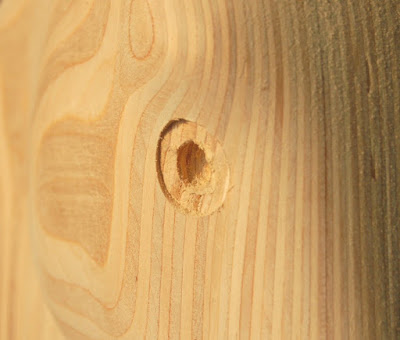On to the Rails
At this stage, with the stand and the horse's body completely assembled, I decided to make a small modification to the two rails. These are the lengths of wood to which the horse's feet get bolted, and which receive the ends of the hangers. As supplied, these were shaped to a point at each end, and were pre-drilled for the hangers, but they had sharp square edges. As all the stand's parts had nicely chamfered edges, I decided to add a chamfer to the rails as well.
The only slightly tricky thing here was to NOT chamfer the two areas on each rail where the horse's feet would go; I didn't want to be left with a gap where the chamfered edge ran under the feet. With the stand and the horse's body and legs assembled, I dry-fitted everything together so that I could lower the horse on the rails, drill holes for the horse's mounting bolts, and mark the outline of where each foot overlapped onto the rail.
With this done, I used a chamfering bit in my router table to chamfer all round each edge of the rails, except for where the feet would eventually be, as shown in the photo below. I have a relatively cheap router table from Rutlands which made life easier, but you could use a hand-held router just as well for this job (or even do it by hand with a plane and a file, if you have the skills and patience for that). Approaching the marked foot areas, I backed the work piece away from the bit to leave what I have found is rather wonderfully called a 'lark's tongue'.
With a bit of sanding, the rails were then ready for finishing.
| Rails as supplied - note the sharp edges |
The only slightly tricky thing here was to NOT chamfer the two areas on each rail where the horse's feet would go; I didn't want to be left with a gap where the chamfered edge ran under the feet. With the stand and the horse's body and legs assembled, I dry-fitted everything together so that I could lower the horse on the rails, drill holes for the horse's mounting bolts, and mark the outline of where each foot overlapped onto the rail.
With this done, I used a chamfering bit in my router table to chamfer all round each edge of the rails, except for where the feet would eventually be, as shown in the photo below. I have a relatively cheap router table from Rutlands which made life easier, but you could use a hand-held router just as well for this job (or even do it by hand with a plane and a file, if you have the skills and patience for that). Approaching the marked foot areas, I backed the work piece away from the bit to leave what I have found is rather wonderfully called a 'lark's tongue'.
| A chamfer added all round each edge, except for where the horse's foot will eventually be attached. |
With a bit of sanding, the rails were then ready for finishing.



Reliable garage builder in Sydney for custom, steel-frame garages built to last.
ReplyDeleteOutdoor Garage Builder